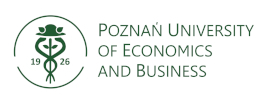
Contemporary marketing strategies for foreign markets
Syllabus
Basic information
- Field of study*
- International Economic Relations
- Specialisation
- International Business
- Organizational unit
- UEP
- Level of qualification
- Second-cycle programme
- Mode of study
- Full-time
- Track
- General academic
- Didactic cycle
- 2020/2021
- Subject code
- UEPMSG03S.21B.8799.20
- Language of instruction
- English
- Mandatory
- Obligatory
- Block
- Block B
|
Period
Semester 1
|
Method of evaluation
Exam
Activities and hours
|
Number of ECTS points
6
|
Subject’s educational aims
| C1 | To present the latest concepts in the context of companies marketing activities on foreign markets |
| C2 | To indicate the importance of internet marketing and new unconventional forms of marketing communication |
| C3 | To present the role of corporate social responsibility in marketing activities along with the marketing of non-profit organizations |
| C4 | To familiarize with complex business relationships and their management in the marketing international activities |
Entry requirements
Principles of Marketing, International Marketing
Subject's learning outcomes
| Code | Outcomes in terms of | Effects | Examination methods |
| Knowledge | |||
| W1 | Student recognizes the latest concepts in the context of companies marketing activities on foreign markets | K2_W01, K2_W02, K2_W14, K2_W15 | Written exam with open questions, Final test, Class participation, Group project / Group work |
| W2 | Student indicates the influence of internet on marketing activities and new unconventional forms of marketing communication | K2_W01, K2_W02, K2_W14, K2_W15 | Written exam with open questions, Final test, Class participation, Group project / Group work |
| W3 | Student identifies the role of corporate social responsibility in marketing activities along with the marketing of non-profit organizations | K2_W01, K2_W02, K2_W14, K2_W15 | Written exam with open questions, Final test, Class participation, Group project / Group work |
| W4 | Student recognizes complex business relationships and their management in the marketing international activities | K2_W01, K2_W02, K2_W14, K2_W15 | Written exam with open questions, Final test, Class participation, Group project / Group work |
| Skills | |||
| U1 | The student questions traditional marketing activities in the international arena | K2_U02, K2_U03 | Written exam with open questions, Final test, Class participation, Group project / Group work |
| U2 | Student plans a marketing strategy of a company in foreign markets, taking into account contemporary market conditions | K2_U05, K2_U06, K2_U07 | Written exam with open questions, Final test, Class participation, Group project / Group work |
| Social competences | |||
| K1 | The student can work in a group and run group discussions | K2_U17, K2_K03, K2_K04 | Class participation, Group project / Group work |
| K2 | The student is able to justify his opinion | K2_K01, K2_K04 | Written exam with open questions, Final test, Class participation, Group project / Group work |
Study content
| No. | Course content | Subject's educational goals | Subject's learning outcomes |
| 1. | Marketing – Introduction | C1 | W1, U1, U2 |
| 2. | Product and firm positioning on international market – contemporary concepts | C1 | W1, U1, U2, K1, K2 |
| 3. | Co-branding on international market | C1, C2 | W1, W2, U1, U2, K1, K2 |
| 4. | Consumers communities and consumers’ involvement in global product development – prosumers | C1, C2 | W1, W2, U1, U2, K1, K2 |
| 5. | Inbound marketing and social media | C1, C2 | W1, W2, U1, U2, K1, K2 |
| 6. | Unconventional forms of marketing communication | C1, C2 | W1, W2, U1, U2, K1, K2 |
| 7. | Marketing of luxury brands | C1 | W1, U1, U2, K1, K2 |
| 8. | Positioning of high-tech products and services on International market | C1, C2 | W1, W2, U1, U2, K1, K2 |
| 9. | Corporate Social Responsibility on foreign markets | C1, C3 | W1, W3, U1, U2, K1, K2 |
| 10. | Marketing of non-profit organizations on foreign markets | C1, C3 | W1, W3, U1, U2, K1, K2 |
| 11. | Global business networks, variety of stakeholders and relationships | C1, C2, C4 | W1, W2, W4, U1, U2, K1, K2 |
| 12. | Global Account Management | C1, C2, C4 | W1, W2, W4, U1, U2, K1, K2 |
Bibliography
Obligatory- K. Fonfara (ed.), The development of business networks in the company internationalisation proces, Poznań University of Economics Press, Poznań 2012
- M. Kotabe, K. Helsen, Global Marketing Management, Wiley 2003
- Journal papers and case studies presented during lectures and practical classes
- Journal papers presented during lectures and classes
Course advanced
Teaching methods:
Brainstorming, Lecture with multimedia presentation, Discussion, Case study, Exercises
| Teaching methods | Method of evaluation | Credit conditions |
|---|---|---|
| Classes | Final test, Class participation, Group project / Group work | Class participarion, group work and final test |
| Lectures | Written exam with open questions | Written exam with open questions |
Calculation of ECTS points
| Activity form | Activity hours* | |
| Participation in classes | 30 | |
| Participation in lectures | 30 | |
| Participation in the exam | 2 | |
| Preparation for exam | 20 | |
| Preparation for classes | 30 | |
| Preparation for test | 30 | |
| Consultations with teacher | 10 | |
| Student workload |
Hours
152
|
ECTS
6.0
|
| Workload involving teacher |
Hours
72
|
ECTS
2.5
|
| Practical workload |
Hours
30
|
ECTS
1.0
|
* one hour of classes = 45 minutes